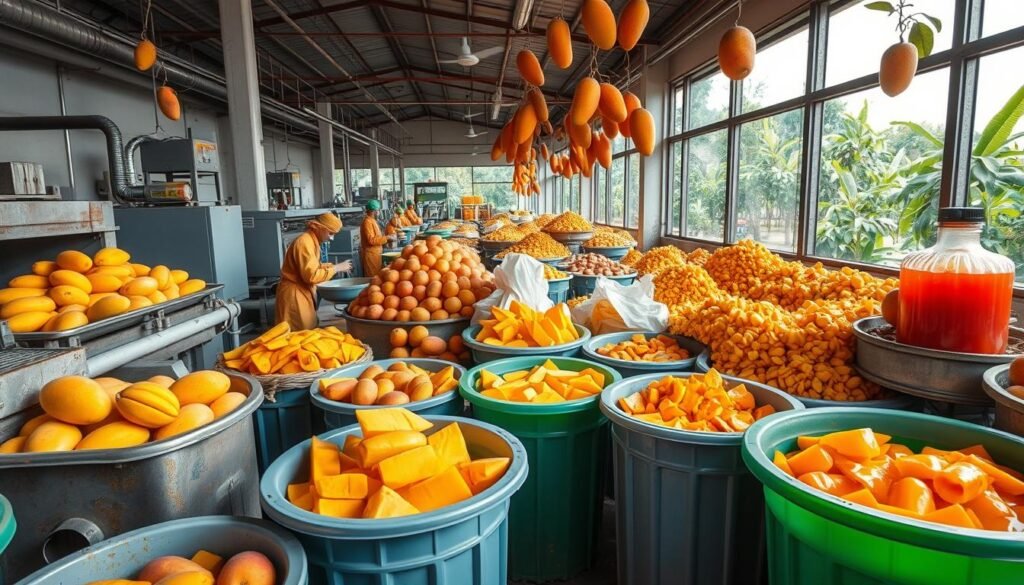How can we turn the simple mango into a top-notch product? As we explore mango processing, it’s clear that using new fruit processing tech is key. With mangoes becoming more popular, we need to use the latest mango peeling and cutting methods. These methods should meet consumer tastes and help the mango industry in Thailand grow.
Knowing about different mango types, like the Amélie and Kent, helps us choose the right processing ways. We also need to tackle issues like reducing waste and making our processes more efficient. By focusing on these areas, we can make sure our methods are not just good but also sustainable for the mango industry’s future.
Key Takeaways
- Mango processing is crucial for meeting consumer demands and enhancing economic viability.
- Advanced technologies in mango peeling and cutting improve product quality.
- Different mango varieties, like Amélie and Kent, have unique biochemical characteristics that affect processing.
- Maximizing efficiency while minimizing waste is essential for industry sustainability.
- Technological advancements can significantly elevate the standard of mango products.
The Importance of Mango Processing in Today’s Market
The mango processing industry is key in meeting the growing demand for fruit products like juices and snacks. In 2020, the world produced about 54.83 million tons of mangoes. This shows how important it is to have good ways to keep mangoes fresh.
Losses after mangoes are picked are huge, at 31%. This is because of decay, bruising, and weight loss. New ways to keep mangoes fresh can help reduce these problems. This ensures that people get the best mango products.
Places like Rajshahi and Chapai Nawabgonj in Bangladesh can really benefit from better mango processing. For example, picking mangoes with at least 13 ° Brix and using a 0.5 mm mesh can make the product better.
The mango processing industry does more than just make products. It also creates jobs and helps farming be more sustainable. Using new technologies helps keep mangoes nutritious and tasty. This makes them popular worldwide. It also helps local economies grow.
| Aspect | Description |
|---|---|
| Post-Harvest Losses | 31% loss due to decay, bruising, and weight loss |
| Minimum Soluble Solids | 13 ° Brix required for fruit selection |
| Pulping Mesh Size | 0.5 mm for a smooth puree |
| Thermal Treatment | Heat pulp to 95°C for 10 minutes |
| Specifications | Mango pulp pH value must be less than 4.00 |
Understanding Different Varieties of Mangoes
Exploring mango processing starts with knowing the different mango varieties. Each variety has its own taste, texture, and processing methods. The Thai market is famous for its wide range of mangoes, offering unique options that affect product quality.
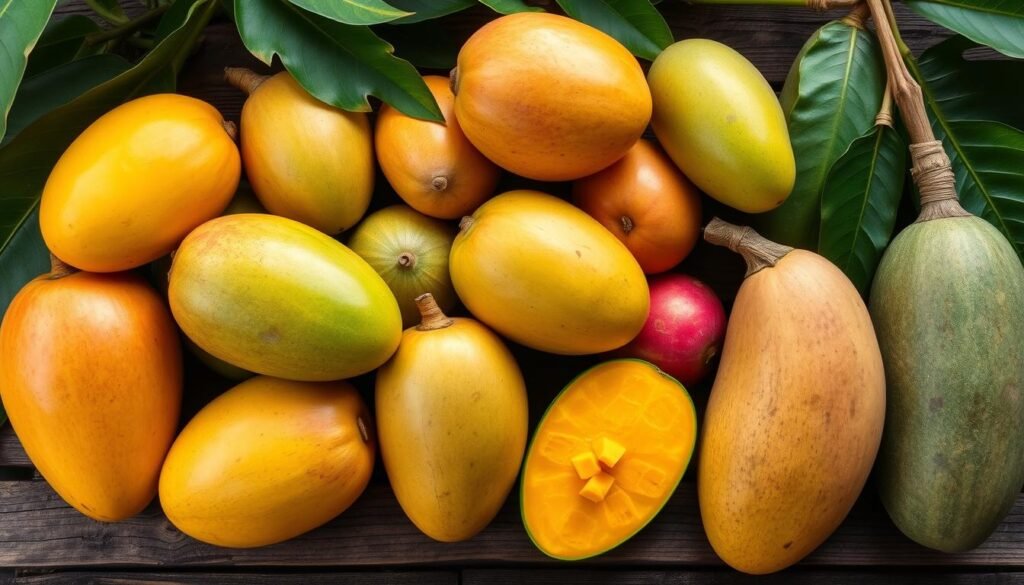
In Thailand, Nam Dok Mai mangoes are known for their sweetness and softness, perfect for making juice. On the other hand, Kesar mangoes have a rich flavor and color, making them great for purées. The Haden variety, though less common, is also used to make high-quality dried mango snacks. Each variety brings its own special qualities to our mango processing, improving the final products we offer.
| Mango Variety | Flavor Profile | Common Uses in Processing |
|---|---|---|
| Nam Dok Mai | Sweet, fragrant | Juice extraction, fresh consumption |
| Kesar | Rich, tropical | Purée production, desserts |
| Haden | Fruity, slightly tart | Dried mango snacks, salsas |
Knowing about these mango varieties helps us refine our processing techniques. As the demand for processed mango products grows, we must keep improving to meet consumer needs.
Mango Processing Techniques
The art of mango processing involves many techniques to improve quality and yield. From peeling to cutting, each step is crucial. We’ll look at key methods that make the process smoother and keep the fruit’s quality high.
Key Techniques in Mango Peeling
Mango peeling is key to processing this vibrant fruit. Different methods affect quality and cost. Here are some peeling techniques:
- Mechanical Peeling: Machines remove the skin with less waste. It’s best for big operations.
- Steam Peeling: Steaming makes skin removal easier, keeping fruit quality high. It’s a top choice for quality.
Advanced Mango Cutting Methods
Advanced cutting methods improve the look and consistency of mango products. The precision in cutting affects the quality of dried mango and canned items. Key techniques include:
- Precision Dicing: Cutting mangoes into uniform cubes ensures even drying and better presentation.
- Slicing Techniques: Specific slicing patterns create visually appealing products for retail.
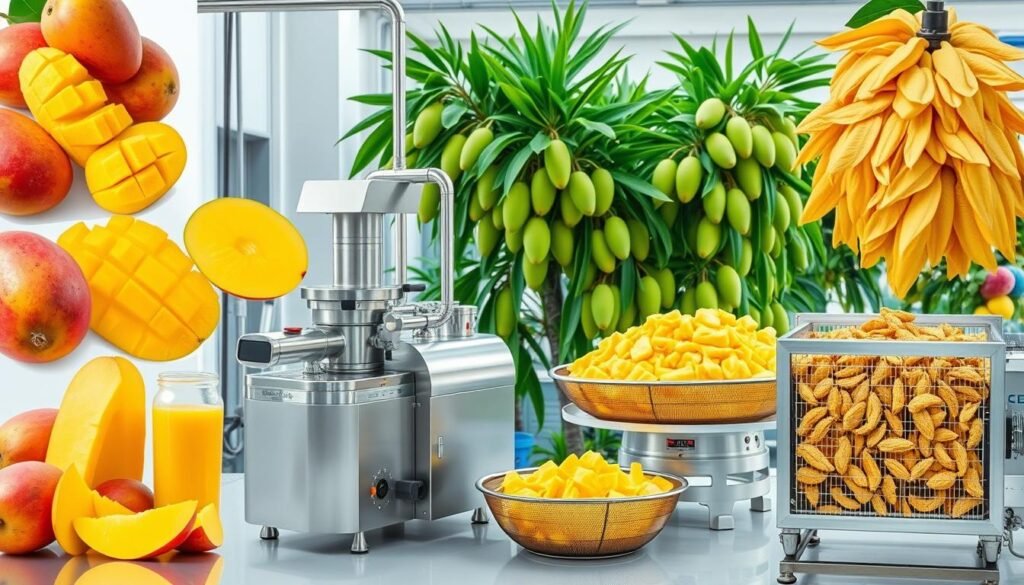
Using these techniques, we can make a variety of mango products. This ensures quality and boosts production efficiency. By improving peeling and cutting, we meet market demand and innovate with new mango products.
| Peeling Technique | Advantages | Disadvantages |
|---|---|---|
| Mechanical Peeling | High efficiency and low labor costs | Potential for waste if not calibrated correctly |
| Steam Peeling | Preserves fruit quality and reduces damage | More time-consuming and requires equipment |
| Precision Dicing | Uniformity in product size enhances appeal | Requires skilled labor and precise machinery |
| Slicing Techniques | Improves presentation for retail products | Possible inconsistency in slice thickness |
Critical Innovations in Fruit Processing Technology
The mango processing industry is changing fast. New technologies are making it more efficient and improving product quality. These advancements use energy-saving methods and advanced techniques to boost output and reduce environmental harm.
Energy-Saving Technologies and Their Impact
Energy-saving tech is leading the way in fruit processing. Methods like microwave and ohmic heating cut down on energy use. They help make products faster, saving money for processors.
High-Pressure Processing (HPP) for Quality Preservation
High-Pressure Processing (HPP) is changing mango processing. It kills harmful bacteria while keeping nutrients, flavor, and color in mango products. This makes sure consumers get top-quality mangoes.
As the European market wants better mangoes, HPP helps processors stand out. It improves product safety and boosts brand reputation.
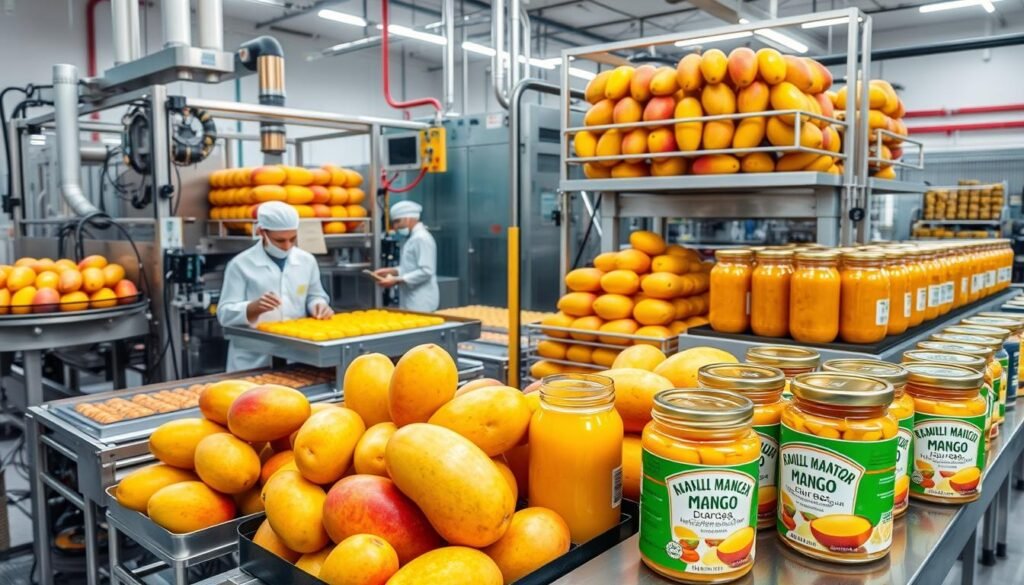
Mango Peeling and Cutting: Essential Tools and Equipment
Having the right mango processing equipment is key for efficient mango peeling and cutting. Various machines help us work better and faster.
The industrial mango peeling machine is a must-have. It peels many mangoes quickly, handling all sizes and shapes. You can adjust how thick the peel is and the radius width for different mango types. This makes sure our mango products stay good while we make more.
Large mango cutting machines are also a big hit in kitchens. They cut mangoes fast and accurately. Some can cut up to 800 mangoes an hour, making sure all pieces are the same size. This is important for making lots of mango products.
Using an automatic mango cutting machine saves a lot of work and waste. It can cut up to 48 fruits a minute, with very little waste. This means we save money and work less than with other machines.
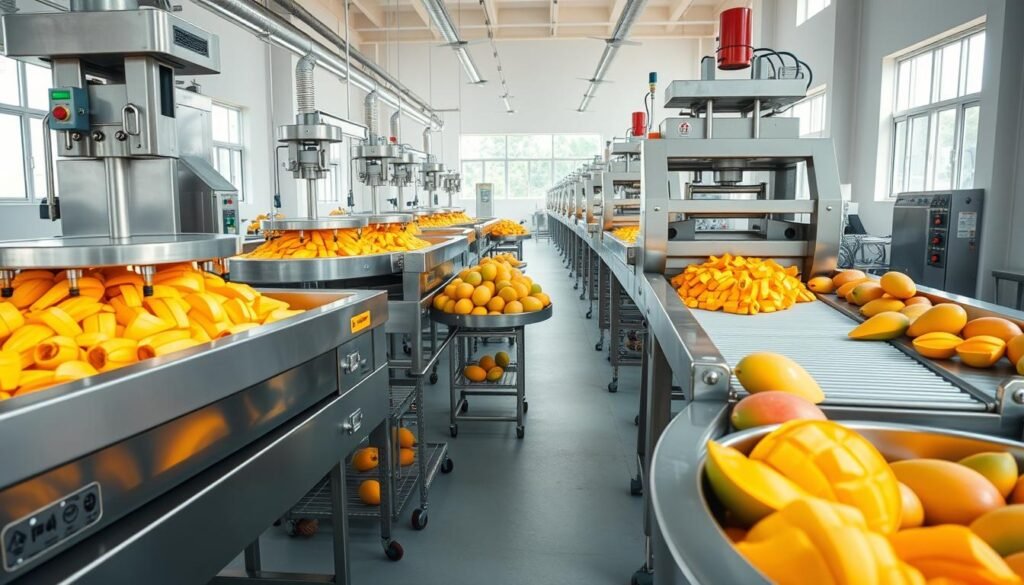
Li An machinery is a leader in making these machines better. Their equipment can handle lots of mangoes, works simply, and doesn’t break down often. This means we can work more and have less downtime.
In short, using top-notch mango processing equipment changes how we peel and cut mangoes. It leads to better quality and work. The right tools are crucial for anyone wanting to do well in mango processing.
Challenges in the Mango Processing Industry
The mango processing industry faces many challenges. We need new solutions to work better and make high-quality products. Our main goals are to reduce waste and increase efficiency. These are key for our industry’s success and growth.
Minimizing Waste and Maximizing Efficiency
It’s important to know how much waste we make during processing. Fruit peels can make up a lot of waste, from 15% to 60%. To solve these problems, we need to take several steps:
- Implementing effective waste management systems to use mango peels and seeds for valuable compounds.
- Utilizing advanced extraction techniques to get more value from by-products and cut down waste.
- Investing in state-of-the-art processing technologies to use resources better and improve efficiency.
- Training employees in good sanitation and maintenance to lower contamination risks and keep operations smooth.
Maintaining Quality Amidst Demand Fluctuations
Keeping quality up is hard, especially when demand changes. We must watch how raw materials and what customers want change. To handle these issues, we can:
- Implementing robust inventory management systems to manage stock well and cut down on waste.
- Adopting flexible processing technologies that can handle different mango types and keep quality high.
- Strengthening supply chain collaborations to get quality fruit on time and reduce supply risks.

Emerging Trends in Mango Preservation Techniques
The demand for quality mango products is growing fast. New ways to preserve mangoes are leading the way in fruit processing. Freeze-drying is one method that removes moisture, keeping mangoes fresh for a long time. It also keeps the vitamins and minerals intact.
Vacuum packing mangoes is another promising technique. It keeps oxygen out, which helps mangoes stay fresh longer. Natural preservatives are also becoming popular. They are organic and good for the planet, appealing to health-conscious consumers.
Sustainable mango preservation is key to reducing food waste and helping the environment. By using these advanced methods, producers make the supply chain more efficient. They also help keep our planet healthy.
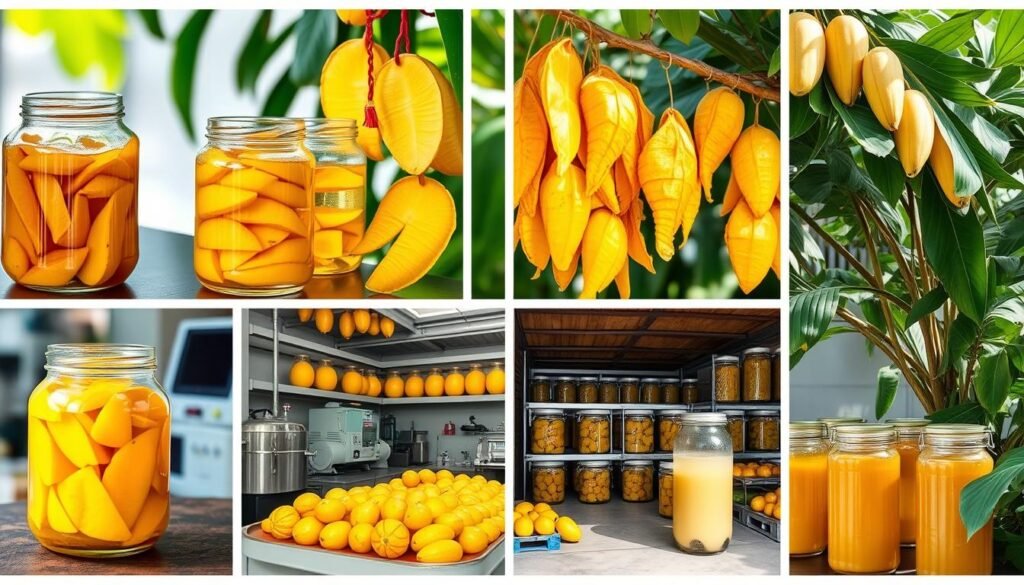
| Preservation Technique | Description | Benefits |
|---|---|---|
| Freeze-Drying | Removes moisture to prevent spoilage | Retains nutrients, lightweight for shipping |
| Vacuum Packing | Seals mangoes in an oxygen-free environment | Extends freshness, reduces waste |
| Natural Preservatives | Utilizes organic compounds to inhibit spoilage | Health-conscious options, cleaner labels |
In conclusion, using these mango preservation techniques meets today’s consumer needs. It also supports sustainability in the fruit processing industry. The future looks bright for more innovative ways to keep mangoes fresh.
Conclusion
Exploring mango processing shows it’s key to making the most of mangoes in today’s market. India grows 38.6% of the world’s mangoes, and Mexico leads in exports. This makes advanced processing and technology very important.
Using new techniques can cut down on losses that can reach up to 80%. This way, we can make sure high-quality mango products get to consumers quickly.
Our focus on preserving mangoes shows the need for top-notch machines and methods. This includes the mango pulper and modern sterilization. These tools help keep products fresh and flavorful.
By using these technologies, we increase efficiency and meet market needs. Products like mango pulp, juice, and slices are now in demand in places like the USA and UAE.
Looking ahead, we’re excited about investing in new solutions for mango processing in Thailand. Machines like those from Li An can make a big difference. They help us stay competitive, improve product quality, and support the livelihoods of mango farmers and processors.
FAQ
What is the significance of mango processing in today’s market?
Mango processing is key because people want more processed fruit. It creates jobs, brings in money, and helps farming stay green. Plus, it keeps mangoes tasty and healthy.
What are some common techniques used in mango peeling?
To peel mangoes, people use machines or steam. Both methods get rid of the skin well. But, the right method can make a big difference in how good the fruit is.
How does the processing of different mango varieties affect product quality?
Each mango type, like Nam Dok Mai and Kesar, is special. Their traits change how juice is squeezed out or how they’re dried. This affects the quality of what we get.
What innovations are currently shaping the mango processing industry?
New tech like microwave heating and High-Pressure Processing (HPP) are changing mango processing. They save energy, speed up work, and make mango products safer and better.
What equipment is essential for efficient mango peeling and cutting?
You need machines for peeling and cutting, and systems for sorting. Using top-notch gear from companies like Li An machinery boosts efficiency and keeps products perfect.
What challenges does the mango processing industry face?
The industry struggles with high costs, changing supply chains, and keeping quality up. Finding ways to cut waste and work smarter is key to beating these hurdles.
What are some emerging trends in mango preservation techniques?
New trends include freeze-drying, vacuum sealing, and using natural preservatives. These methods help keep mangoes fresh, tasty, and full of nutrients while being eco-friendly.
Source Links
- IJB-V22-No4-p1-15 – https://innspub.net/download/?target=wp-content/uploads/2023/05/IJB-V22-No4-p1-15.pdf_36673
- Sourcing Organic Dried Mango in Burkina Faso and Ivory Coast. – Abbott Blackstone International – https://abbottblackstone.eu/all-articles/sourcing-organic-dried-mango-in-burkina-faso-and-ivory-coast/
- PDF – https://openknowledge.fao.org/server/api/core/bitstreams/f6bf4e89-275b-42a2-a402-b53255feaa04/content
- Commercial Processing of Mangoes – The Mango Factory – https://www.themangofactory.com/nutrition/commercial-processing-of-mangoes/
- Research Progress on Mango Post-Harvest Ripening Physiology and the Regulatory Technologies – https://pmc.ncbi.nlm.nih.gov/articles/PMC9818659/
- Improving Mango Quality – Felix Instruments – https://felixinstruments.com/blog/improving-mango-quality/
- Fruit Characteristics, Peel Nutritional Compositions, and Their Relationships with Mango Peel Pectin Quality – https://pmc.ncbi.nlm.nih.gov/articles/PMC8226707/
- Fruit and vegetable processing – Ch08 Fruit specific preservation technologies (cont.) – https://www.fao.org/4/v5030e/v5030e0p.htm
- PDF – http://celkau.in/Agrienterprises/enerprise/28.Processing of Fruits/1. PROCESSING OF MANGO.pdf
- Mango Peeler – https://www.foodstream.com.au/news/mango-peeler/
- Exploring the Addition of Mango Peel in Functional Semolina Sourdough Bread Production for Sustainable Bio-Reuse – https://www.mdpi.com/2076-3921/13/11/1278
- Mango Fruit Processing: Options for Small-Scale Processors i – https://ideas.repec.org/a/gam/jagris/v11y2021i11p1105-d673377.html
- How to Cut a Mango—the Hassle-Free Way – https://www.realsimple.com/food-recipes/cooking-tips-techniques/preparation/cut-mango
- WO2014097329A1 – Processing and peeling machine for mango – https://patents.google.com/patent/WO2014097329A1/en
- PDF – https://www.thecommonwealth-ilibrary.org/index.php/comsec/catalog/download/868/868/7208?inline=1
- HS1443/HS1443: Fresh-Cut Mango Best Management Practices Manual – https://edis.ifas.ufl.edu/publication/HS1443
- Mango Peels as an Industrial By-Product: A Sustainable Source of Compounds with Antioxidant, Enzymatic, and Antimicrobial Activity – https://pmc.ncbi.nlm.nih.gov/articles/PMC10888073/
- Mango Fruit Processing: Options for Small-Scale Processors in Developing Countries – https://www.mdpi.com/2077-0472/11/11/1105
- Recent advances for postharvest protection and preservation of mango fruit: a review – https://www.myfoodresearch.com/uploads/8/4/8/5/84855864/_36__fr-2022-105_moreno.pdf
- Mango Peel: An Eminent Food Source | Auctores – https://www.auctoresonline.org/article/mango-peel-an-eminent-food-source
- Mango juice making process, the steps in mango juice processing – https://www.ticomachine.com/faq/mango-juice-making-process.html

